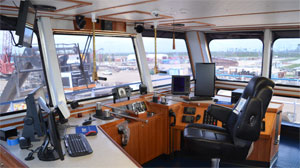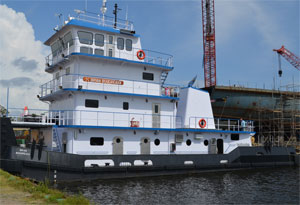In early May, Eastern Shipbuilding of Panama City, Fla., delivered the 90-foot Brian Boudreaux, the 68th vessel in a series of inland pushboats. The 3,000-hp, conventionally propelled vessel is named for a longtime billing manager at the Mandeville, La., towing firm.
Although navigation electronics, engines and interior outfitting evolved with the times, the core design has remained virtually unchanged since Rhonda Lamulle left Eastern in early 2006. Jeff Brumfield, Florida Marine’s director of vessel construction and engineering, hasn’t forgotten that day.
“The first one was delivered Feb. 22, 2006,” he said in a recent interview. “I remember it to the hour.”
The Canal class remains the largest single-vessel, single-shipyard order in U.S. history, and two more tugs are under construction. Those two, bringing the order total to 70 vessels, are expected by the end of the year. D.J.P. II is named for company president Dennis J. Pasentine, son of company founder Dennis A. Pasentine. Jaden Pasentine, named for the son of Dennis J. Pasentine, will be the final tug in the series.
The sheer longevity of the project speaks volumes about the vessels’ performance. Although they primarily tow two tank barges, Canal-class tugs are just as capable of shifting barges, fleet work and other towing jobs that come along.
 |
|
Electrical power comes from twin John Deere 99-kW gensets. |
|
Courtesy Eastern Shipbuilding |
“The 90-foot boat has proven very versatile for us,” Brumfield said. “It can do the work of a 1,200-hp boat if it needs to and just push one barge. It can do that without hurting you on fuel and still be competitive. But then it can do the work of a 2,800- or 3,000-hp boat and be competitive.”
“For our operation,” he continued, “it’s just a wonderful size that is really versatile for what we do.”
Florida Marine is one of the largest U.S. towboat operators. It runs more than 90 towboats across the Gulf Intracoastal Waterway from Corpus Christi, Texas, to Florida, and throughout the inland waterway system from Pittsburgh to Minneapolis to New Orleans. The Canal class is the backbone of the fleet with 49 vessels still working. Eighteen others have been sold over the years.
“We have a couple boats that are smaller and we have several that are larger, but that has been the meat and potatoes for us,” Brumfield said.
Eastern Shipbuilding provided plans for the 25-boat order that launched the series in the mid-2000s. After that huge order, FMT added vessels a handful at a time. Horsepower grew over the years from 2,400 to 2,600 to 2,800, and finally to the current 3,000 as engine technology improved.
Gilbert Associates of Braintree, Mass., updated the vessel plans to accommodate the more powerful Cat engines. John Gilbert, the firm’s namesake naval architect, said the design has been optimized for performance and maneuverability, especially in shallow water.
 |
|
Florida Marine Transporters takes pride in its towboat interiors. Crew spaces are designed with many comforts of home. The kitchen area, for instance, has granite countertops. |
|
Courtesy Eastern Shipbuilding |
“For all intents, the boats are self-propelled barges, and getting water to the wheels is very important for not only thrust but reducing vibrations,” he said. “Given that water will be limited from before the propeller, water must be free to move in from the sides.”
Depending on the tow and river conditions, recently built Canal-class towboats can push upriver at 5 or 6 knots. Free-running speed is closer to 8.
The interior design of the towboat has been standardized across the series, as have many of the components. The main deck has the upper engine room aft with a crew galley and mess forward. Laundry machines, head, safety station and storage areas separate the two spaces. The 01 deck has a workout area, lounge and two single staterooms, while the 02 deck has a double bunk and two single rooms with two heads.
The wheelhouse has a 33-foot height of eye. Like its predecessors, Brian Boudreaux is outfitted with Furuno radar and AIS with Rose Point navigation software. Ritchie supplied the compass, while the three radios came from Standard Horizon. The wheelhouse layout, like the rest of the interior, closely mirrors others in the class.
Brian Boudreaux’s propulsion system consists of twin Caterpillar 3512C Tier 3 mains rated for 1,500 hp at 1,600 rpm turning 84-inch, four-bladed Sound Propeller props through Twin Disc reduction gears at a 6.56:1 ratio. Ship service power comes from twin John Deere 4045 gensets each producing 99 kW. The gensets are located in the upper engine room with the mains installed in the lower engine space. On deck, twin Patterson 40-ton winches are installed at the bow. EMI supplied the steering system.
 |
|
Florida Marine Transporters has standardized its wheelhouse design across the fleet. Brian Boudreaux has the latest Furuno radars and AIS system. |
|
Courtesy Eastern Shipbuilding |
Florida Marine crews typically work 28-day hitches followed by 14 days off. Crew comfort industry-wide has become a big factor in crew retention. To that end, Florida Marine’s newbuilds feature attractive touches that include granite countertops as well as ample insulation to keep noise and vibration down. Wireless Internet is available throughout the vessel, and each stateroom has a cable TV connection.
“We make the boats as nice and comfortable as we can. Retaining crew is a part of this for us,” Brumfield said.
He has suggested in the past that the Canal-class project was coming to an end. This time, that’s almost certainly the case. Once tugs 69 and 70 are finished, likely by the end of the year, Florida Marine will be out of Tier 3 engines and keels, meaning a similar vessel will require Tier 4 engines. That, in turn, will require design changes.
Gilbert is developing a new 96-foot design to succeed the Canal class. The new plans will incorporate Cat Tier 4 engines and selective catalytic reduction (SCR) modules as well as tankage for diesel exhaust fluid (DEF). The SCR modules will be installed within the stacks to save space in the engine room, he said.
Other than the work at Eastern, Florida Marine has 10 other towboats under construction at four shipyards, including its own yard in Harvey, La. Other work is spread across Metal Shark-Alabama, Gulf Island Shipyards and Steiner Shipyard.
Each of these new towboats will no doubt be a welcome addition to the fleet. But they also have a long way to go to match the longevity, pedigree and track record of the Canal class.

